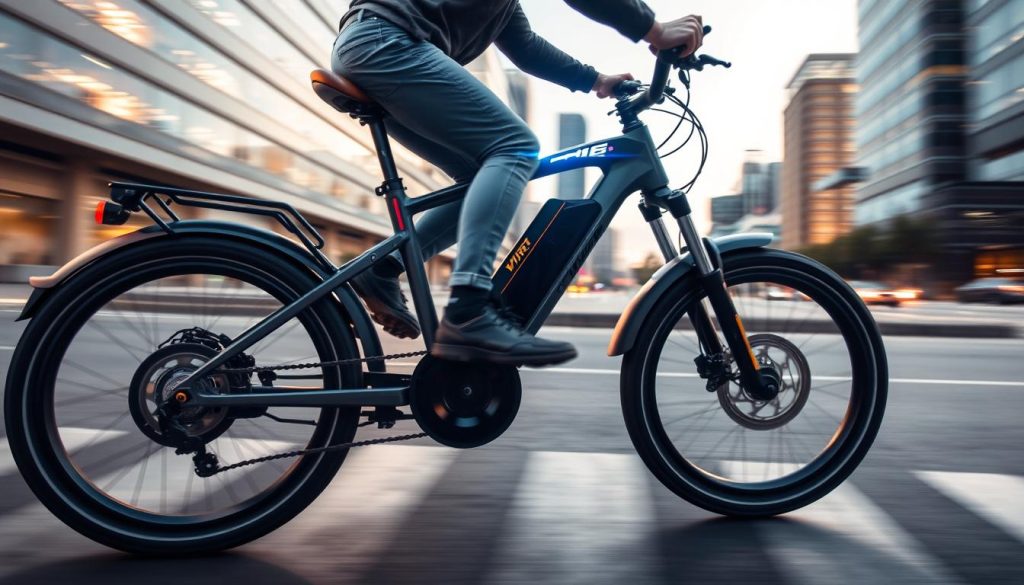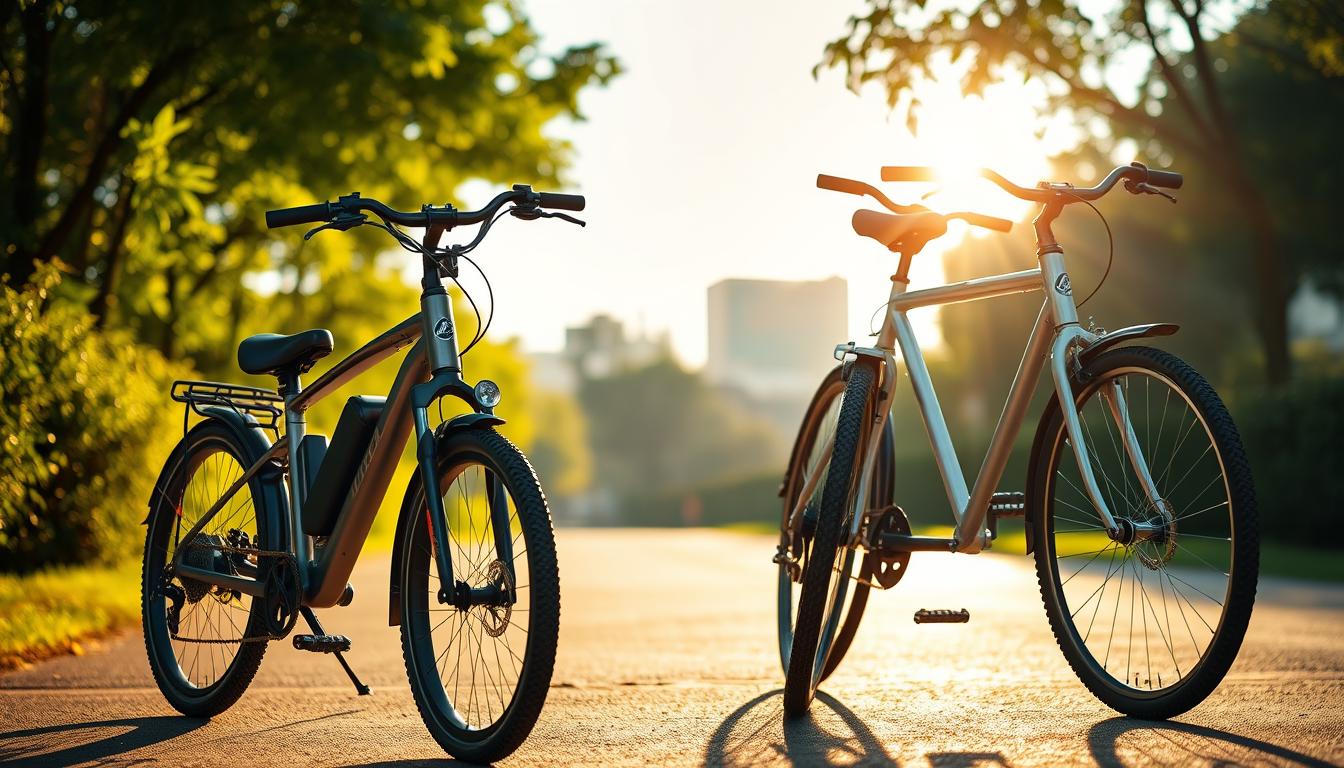Choosing between modern cycling options can feel overwhelming. This guide breaks down the essentials to help you decide what fits your daily routine, budget, and goals. We’ll explore design features, performance differences, and practical factors like maintenance and long-term value.
Today’s electric bikes blend classic cycling with smart tech. They share the frame and handlebars of a regular bike but add a motor, battery, and intuitive controls. Features like pedal assist modes let riders tackle hills or extend their range effortlessly.
Traditional bikes remain popular for their simplicity and affordability. While they lack motors, their lightweight designs appeal to fitness-focused riders. Maintenance for standard models often costs less upfront compared to electric versions.
We’ll compare real-world experiences from commuters and weekend adventurers. You’ll learn how terrain, riding habits, and personal preferences shape the decision. Whether you prioritize speed, exercise, or eco-friendly travel, this article prepares you to choose confidently.
Understanding the Design and Mechanical Differences
The foundation of both electric and manual bikes lies in their familiar structures. At first glance, they share identical frames, handlebars, and wheels. Even components like brakes and gears often come from the same manufacturers.
Visual and Structural Similarities
Both styles use lightweight aluminum or steel frames for durability. You’ll find similar saddles, pedals, and chain systems across models. This shared DNA makes switching between them feel natural for most riders.
Unique Features of Electric Assistance
Electric models add a quiet motor and removable battery to boost your ride. These systems kick in during pedaling, offering adjustable assistance through handlebar controls. A backlit LCD screen displays speed, battery life, and power modes.
The motor’s push varies based on your pedaling effort and selected mode. Unlike traditional cycling, hills become manageable without exhausting climbs. Riders can choose between full manual control or letting the system share the workload.
| Feature | Electric Bikes | Traditional Bikes |
|---|---|---|
| Power Source | Motor + Battery | Leg Strength |
| Key Components | LCD Display, Throttle | Basic Gear Shifters |
| Speed Control | Pedal Assist Modes | Manual Shifting |
| Weight | 45-60 lbs | 20-30 lbs |
Exploring Performance and Riding Experience
Performance differences shape how cyclists conquer roads and trails today. Advanced systems in modern cycles reduce physical strain while maintaining momentum. Let’s examine how technology reshapes speed management and energy use.
Pedal Assist and Throttle Control
Pedal-assist modes amplify your effort using sensors that detect leg movement. Riders select power levels through handlebar buttons, blending human input with motor support. Throttle control offers instant acceleration without pedaling—ideal for quick starts at intersections.

These features make steep climbs feel manageable and long distances less tiring. By adjusting assistance, you conserve energy for later miles or challenging terrain.
Speed Capabilities and Energy Efficiency
Most electric models reach 20-28 mph, outpacing traditional cycles on flat roads and inclines. Consistent speed is easier to maintain, reducing stop-and-go fatigue during commutes. The motor’s efficiency shines over extended rides, as it compensates for wind resistance or heavy loads.
Battery life varies based on power usage, but smart riders balance pedal input with motor help. This strategy extends range while keeping effort low—perfect for multi-stop errands or scenic weekend tours.
E-Bike vs. Traditional Bike: Which One Is Right for You?
Finding the best cycling option depends on how you balance exertion and adventure. Riders often face trade-offs between physical challenge and practical efficiency. Let’s break down how different models handle daily demands.
Effort Levels and Distance Coverage
Pedaling a standard cycle requires full leg power, especially on inclines. Motor-assisted models reduce muscle strain by up to 70%, according to rider surveys. This lets commuters tackle 20-mile trips without arriving sweaty.

| Aspect | Motor-Assisted | Pedal-Only |
|---|---|---|
| Average Effort | Low-Moderate | High |
| Max Distance (miles) | 40-80 | 15-30 |
| Steep Terrain | Effortless Climb | Intense Workout |
| Fitness Impact | Light Exercise | Full-Body Burn |
Real-World Riding Experiences
Portland commuter Mia shares: “My motorized model erased my fear of hills. I now ride daily instead of driving.” Fitness enthusiasts counter that pedal-only rides burn 500+ calories hourly.
Weekend explorers appreciate assisted models for covering state park trails without exhaustion. Meanwhile, manual cycles remain popular for structured training programs. Your choice hinges on whether you want transportation ease or heart-pumping exertion.
Both options deliver fresh air and freedom. Test rides help clarify which balance of effort and enjoyment fits your lifestyle best.
Cost, Maintenance, and Efficiency Considerations
Smart shoppers weigh both immediate expenses and future savings when choosing wheels. Let’s break down what your wallet and schedule can expect from different models.
Upfront Investment and Long-Term Savings
Motor-assisted models typically cost 3-4 times more than standard bicycles. However, their energy efficiency shines over time. Charging batteries costs pennies compared to gas-powered alternatives.
Many cities offer rebates for electric commuters. Over five years, these savings often offset the initial price gap. Standard models win for tight budgets but lack battery-powered range.
Maintenance Needs and Repair Insights
Both types need chain lubrication and brake adjustments. Electric versions add battery checks and motor diagnostics. Specialized shops handle complex electrical work, while local mechanics can service most mechanical parts.
Consider these key differences:
- Standard bicycles: $100-$300 annual upkeep
- Electric models: $200-$500 yearly maintenance
- Battery replacement every 3-5 years ($300-$800)
Urban commuters save time through quicker trips and reduced parking fees. Weekend riders appreciate extended range without exhaustion. Test rides help find models matching your transportation needs and repair comfort level.
Comparing Usability: Commuting, Fitness, and Delivery Needs
City streets buzz with different cycling needs. Delivery workers zip through traffic, commuters chase schedules, and fitness seekers build endurance. Let’s see how modern two-wheelers adapt to these demands.

Commuter Benefits and Urban Navigation
Electric models shine in stop-and-go traffic. Their instant acceleration helps riders merge safely at busy intersections. Parking becomes easier thanks to compact designs matching regular bikes.
Delivery professionals report completing 30% more orders daily with motor-assisted rides. Reduced pedaling effort means less fatigue during 8-hour shifts. Charging stations now dot most metro areas, keeping batteries topped up.
| Use Case | Electric Bikes | Regular Bikes |
|---|---|---|
| Delivery Speed | 18-22 mph avg | 10-14 mph avg |
| Commute Comfort | Low exertion | High exertion |
| Terrain Handling | Effortless climbs | Manual power |
| Daily Range | 40+ miles | 15-25 miles |
Fitness, Recreation, and Delivery Efficiency
Traditional cycles remain popular for calorie-burning workouts. A 45-minute ride burns 400+ calories, appealing to health-focused people. Weekend riders enjoy the challenge of manual pedaling on trails.
Hybrid approaches are emerging. Some delivery workers use electric models for work shifts but switch to regular bikes on days off. This balance maintains fitness while meeting job demands.
Your choice hinges on priorities. Need speed and reduced effort? Electric versions excel. Crave intense exercise? Standard models deliver. Test both to discover your perfect match.
Final Thoughts on Choosing Your Perfect Bike
Your ideal ride depends on matching tech features to daily needs. Electric models excel with motor-powered assistance for hills and longer distances, while regular bicycles offer simplicity for short commutes or intense workouts. Consider battery life and maintenance costs—these factors shape long-term satisfaction.
Real riders highlight key differences. Commuters praise pedal-assist modes for stress-free urban travel, while fitness fans value the calorie burn of manual rides. Testimonials show varied preferences: some prioritize speed (15-28 mph), others focus on upfront cost or repair simplicity.
Key components like motor power levels and battery efficiency define performance. E-bikes reduce effort but require charging, whereas traditional types demand physical stamina. Both deliver eco-friendly benefits, but their maintenance needs differ significantly.
Your choice ultimately reflects personal priorities. Need help finding balance? Test both types locally. Understanding these differences ensures you’ll enjoy every ride, whether chasing fitness goals or cruising neighborhood streets. Happy cycling!

